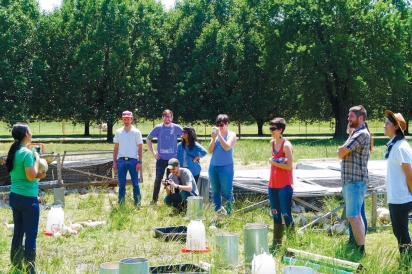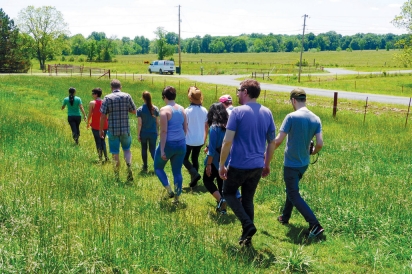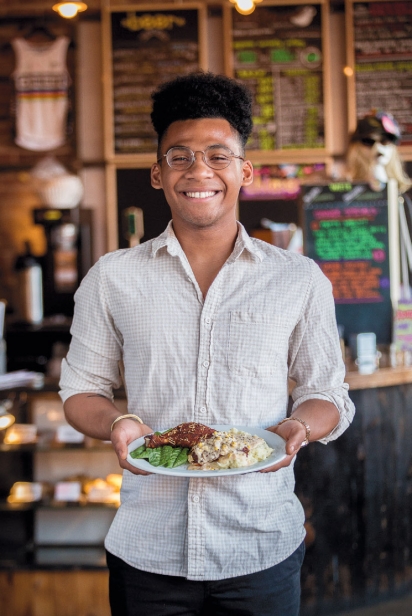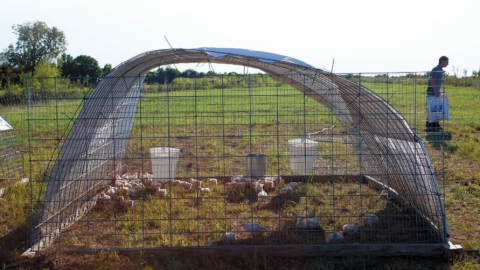The Farm and the Table
At first glance, Angela Faughtenberry’s chickens and roosters look like they have escaped: They can be found poking around in grasses, hesitantly investigating the pigs’ enclosure, scratching for worms and other chicken delights. They seem to say “free range” with every strut. One of the key components to Faughtenberry’s farming philosophy at 413 Farm is rotating her animals. By regularly moving the chickens and pigs to a new location on her property, it eases their impact on the land, and spreads the benefit as well.
This year 413 Farm is raising 6,000 chickens. This is more birds than Faughtenberry typically raises, but the Tulsa food community is doing something special, with 413 Farm in Adair as its keystone. The sale of these chickens doesn’t depend on fluctuations in sales at market—they are already spoken for. Rob Stuart, owner of Chimera Café in downtown Tulsa, wants them all.
He approached 413 Farm about creating a long-term partnership wherein he promises to purchase the birds she raises, and she provides every chicken breast the café uses. This handshake deal has raised the standard for local chefs and restaurants in sustaining a local food economy.
The Table
Late on a Tuesday afternoon in the Brady Arts District in downtown Tulsa, there is nowhere to park and only a few places to sit inside Chimera Café. There are business meetings, lunch dates, and the bar is host to a few early happy hour customers. It is bustling for 3pm on a weekday. Stuart has a quiet, thoughtful countenance, and when I arrive he is finishing lunch rush cleanup.
The menu features many local farms and companies and is “vegetarian, with meat options,” as Stuart puts it. He is unapologetically clear on his standards for the café: He wants clean ingredients, organic vegetables and hormone-free poultry—all coming from the closest environmentally conscious source possible. Buying ingredients based on these values, instead of price, is a commitment that Stuart calls a no-brainer. “Of course you have to balance food costs. But we’ve eased into it; it is what I’ve been focused on from the beginning.” Little by little, the café is shifting from reliance on ingredients delivered by a grocery service to food delivered by a neighbor. Stuart and his staff are dedicated to knowing as much as possible about what they are putting on your plate.
“We can tell you as much as you want to know about it,” he says. “Or if you just want to enjoy it as a tasty meal, that’s OK too.” When Stuart and Faughtenberry first discussed the prospect of 12,000 chicken breasts, there was a pretty big challenge ahead of them. To raise that many birds just for the breasts without a buyer for the rest of the meat would be economically risky for a small farm like 413 Farm. With the help of the local food marketplace Agruity.com, and a host of other connections in the Tulsa food community, Faughtenberry was able to find buyers for every part of her chickens. With Stuart as an example, many other restaurateurs and chefs are also joining in partnerships of value over volume. Tallgrass Prairie Table, The Reserve at Grogg’s Green Barn and Smoke on Cherry Street are key local supporters who stepped up to take a piece of the “Chimera chickens,” as one chef coined them. As Stuart insists, this is about community, not just a business.
“When you start to lean on each other, ya know, that’s when you start to feel it. When it all really starts to work.”
The Farm
The drive to Adair, Oklahoma, is a Midwest road trip exemplar. As you leave Tulsa to the east, there begins a slow widening between buildings and businesses until the one lane cuts through stretches of muggy green farmland and shade trees. With farmhouses dotted along the path, you can almost feel a slowing down—the bugs hopping across the fields and the farm trucks in front of you all have their own pace.
This is where Angela Faughtenberry lives. She is the farmer behind 413 Farm. You’ve probably seen her at a booth at the Cherry Street Farmers’ Market, or even tasted her poultry on your plate at many Tulsa area restaurants. Faughtenberry comes to Tulsa often for deliveries, but is raising her family on 40 acres at the end of a quiet road in Adair after a move from Texas. Her driveway curves through the property, delivering visitors between a small field of low chicken shelters and her front porch. This is where Faughtenberry begins my introduction to her farm life.
While walking the property, she answers phone calls and a steady stream of text messages regarding her products. While I step around chickens and ducks it is clear that this—the entire farm—is their territory. But when Faughtenberry paces by, the birds seem used to her presence. While she is part of what could be called “slow food,” the woman is busy. With seven kids of her own and a commitment to her community, her goal is to feed families—her own, of course, but also yours. She raises chickens, eggs, pigs, lambs and cows for local restaurants and markets. She does it on a small scale, all with intentional local destinations.
“Market is hard to raise for, it’s so unpredictable” she explains while trekking uphill towards the woods and, as it happens, her pigs. The pigs on the property are headed for Amelia’s on Boston, but currently are forthright in their curiosity and comfort in their current home. To put it plainly, they are the happiest pigs I have ever seen. They will also be rotated to a new part of the property for their continued exploring and fertilizing.
Her practice of rotating their grazing areas is heavily informed by Joel Salatin of Polyface Farm in Swoope, Virginia, furthering his mission of “healing the land, healing the food, healing the economy and healing the culture.” Each of these elements of the farming process—food, land, economy, culture—is connected to and depends upon each other. As a small farm, educating her community on the details of raising animals is part of the job, frequently inviting customers out to see for themselves what a small farm can look like. Terms like “local,” “organic,” “pasture raised” and “fresh” take on new meaning when there isn’t a chemical in sight, the chicken feed comes from the farm one stoplight down, and one can walk right to the pasture where the animals are raised. She shows where her current crop of chickens started their growing season. The grasses are thick and green, heavily fertilized by manure; the soil prepared by the chickens’ scratching. This hay will all be harvested in the fall for use on the rest of the farm. Another step in the circular process of farming at 413 Farm.
Before I leave, Faughtenberry offers a seat on her porch. We try to make as many connections as possible between restaurants we’ve visited and the ingredients they source. She tells me if I get one thing down it should be that “I just want Rob to know what a blessing it is that he trusts me to grow the highest quality chicken and for the opportunity to feed this many families.” She tears up, and apologizes for getting emotional, but it is clear what pushes her to be a driving force for buying locally.









